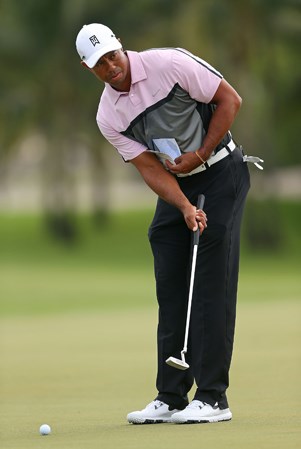Five key elements of the putting stroke
Published:
My mentor, the late, great Alex Hay, had two golden rules for putting: Keep the ball low; Don’t take a divot!
It is a well-used cliché to describe putting as a “game within a game”, but it’s true. On the course, a weekend golfer might score 95 – 30% of those shots are likely to be putts. You can bet that even golfers who practise will not devote 30% of their time to putting. Putting is a skill that can be practised almost anywhere. The more we improve our long game, the more significant putting becomes.
I spoke at the Harmon Brother’s Teaching Summit in Las Vegas a few years ago; on the same bill was Scotty Cameron. He shared his extensive knowledge of the putting strokes of all the players on the US tour, showing us film of their strokes. Incredibly, there are some players whose strokes are near to mechanical perfection. Scotty then showed a couple of examples of strokes that had a slight loop in the path of the putter’s head – surprisingly they belonged to players in the top 10 of putting averages! So, if the putting stroke itself is not the essential requirement, what is?
I think there are five key elements…
TIP #1: Work on “task” over “technique”
Like the long game, you can work on your swing, but still hit bad shots. Similarly, you can work for hours on your putting stroke and still miss crucial putts. In both cases I can assure you that focusing on the “task”, from good preparation, will lead you instinctively to better technique. My favourite adage when coaching long game is “Learn the shot – the swing’s for free”. For putting, the phrase is “Learn to roll the ball – the stroke’s for free”. Let’s be certain about one thing – our desire to “roll” the ball will almost certainly overcome any frailty in your putting stroke.
TIP #2: Work on “rolling” the ball
I’d rather coach a pupil with a flawed stroke who could put a pure roll on their ball, than one with a pure mechanical stroke that couldn’t. Really we need the best of both those worlds. Why is it so important to “roll” the ball you might ask?
- A “rolling” ball holds its line.
- We compute the pace of putt on the assumption of a “pure” roll.
From experience, you can tell if a ball is going in from the moment it leaves the putter. In the same way a lawn bowler can roll their ball 30 yards to within inches of the jack, we can control the pace of our putts by imparting “roll” as soon as the ball is struck.
TIP #3: Practise putting with your right hand only
One of the most damaging concepts regarding putting is the idea of “taking the hands out” of the stroke. Interesting that Tiger Woods starts his putting practice with only his right hand; he knows better than anyone that putting is a creative act rather than a suppressed or stifled one. Rolling a ball is a knack or improvised skill; we must utilise our hands to impart roll. The key is to disguise that creativity within the mechanics of the stroke.
TIP #4: Create your stroke from your address
We all need help to prepare for any golf shot. Swing faults start at address. The best way to improve your putting method is to seek help from your local PGA pro; ask him to help you with the “mechanics” of preparing to putt, and he will check your putter is the ideal length and lie for your physique. He’ll also help you learn to read a putt first, aim the face (probably the hardest of all!), adopt good posture, form a suitable grip and get the correct ball position.
TIP #5: Roll the ball to create your stroke
Most of you reading this column will think about your stroke in the hope of holing the putt. If you were hitting a nail with a hammer, what would you be focusing on – the hammer head or the nail head? The nail head of course! Putting is just the same, focus on the ball and let your subconscious mind control the putter’s head.



